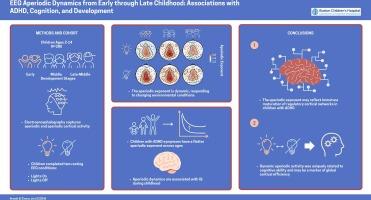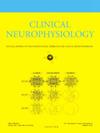从儿童早期到晚期的脑电图非周期性动态:与多动症、认知和发育的关系。
IF 3.7
3区 医学
Q1 CLINICAL NEUROLOGY
引用次数: 0
摘要
背景:非周期性静息脑电图(EEG)活动是动态的,反映了兴奋与抑制(E:I)的平衡随着环境条件的变化而变化。我们对患有或未患有注意力缺陷多动障碍(ADHD)的早期、中期和晚期儿童青少年的跨序列队列中的非周期性和动态非周期性指数的发育和认知相关性进行了研究:285名2-14岁的儿童在高视觉输入和低视觉输入条件下提供静息脑电图。持证临床心理学家确定了多动症的诊断或可能性(幼儿)。对非周期性特征与年龄、多动症诊断、智商和实验条件之间的关系进行了线性回归估计:从儿童早期到中期,非周期性指数呈线性增长,表明 E:I 值较低,随后在儿童晚期呈下降趋势。幼儿的非周期性指数在高视觉输入和低视觉输入时更大,但随着年龄的增长,这种效应发生逆转。多动症组的非周期性指数总体上有所下降。动态非周期性活动,即 E:I 平衡的变化,与智商有关:结论:非周期性指数和非周期性动态是与年龄相关的大脑皮层成熟和 E:I 平衡的代用指标,与多动症症状和认知能力有明显的关联:我们提供的新证据表明,动态非周期性活动是儿童期大脑皮层效率的候选标志。本文章由计算机程序翻译,如有差异,请以英文原文为准。

EEG aperiodic dynamics from early through late childhood: Associations with ADHD, cognition, and development
Background
Aperiodic resting electroencephalography (EEG) activity is dynamic, reflecting shifting excitatory:inhibitory (E:I) balance with changing environmental conditions. We examined developmental and cognitive correlates of aperiodic and dynamic aperiodic indices in a cross-sequential cohort of early, middle, and late childhood youth with and without attention deficit hyperactivity disorder (ADHD).
Methods
Two-hundred eighty-five children ages 2 – 14 years provided resting EEG during high- and low-visual input conditions. Licensed clinical psychologists determined ADHD diagnosis or likelihood (in young children). Linear regressions were estimated to examine associations between aperiodic features and age, ADHD diagnosis, IQ, and experimental condition.
Results
From early to middle childhood, the aperiodic exponent increased linearly, indicating lower E:I, followed by a decreasing trajectory in late childhood. The aperiodic exponent was greater with high versus low visual input in young children, but this effect reversed with age. The ADHD group had a decreased aperiodic exponent, overall. Dynamic aperiodic activity, i.e. shifts in E:I balance, was associated with IQ.
Conclusions
The aperiodic exponent and aperiodic dynamics are proxies for age-related cortical maturation and E:I balance, and have distinct associations with ADHD symptoms and cognitive ability.
Significance
We provide novel evidence that dynamic aperiodic activity is a candidate marker of cortical efficiency in childhood.
求助全文
通过发布文献求助,成功后即可免费获取论文全文。
去求助
来源期刊

Clinical Neurophysiology
医学-临床神经学
CiteScore
8.70
自引率
6.40%
发文量
932
审稿时长
59 days
期刊介绍:
As of January 1999, The journal Electroencephalography and Clinical Neurophysiology, and its two sections Electromyography and Motor Control and Evoked Potentials have amalgamated to become this journal - Clinical Neurophysiology.
Clinical Neurophysiology is the official journal of the International Federation of Clinical Neurophysiology, the Brazilian Society of Clinical Neurophysiology, the Czech Society of Clinical Neurophysiology, the Italian Clinical Neurophysiology Society and the International Society of Intraoperative Neurophysiology.The journal is dedicated to fostering research and disseminating information on all aspects of both normal and abnormal functioning of the nervous system. The key aim of the publication is to disseminate scholarly reports on the pathophysiology underlying diseases of the central and peripheral nervous system of human patients. Clinical trials that use neurophysiological measures to document change are encouraged, as are manuscripts reporting data on integrated neuroimaging of central nervous function including, but not limited to, functional MRI, MEG, EEG, PET and other neuroimaging modalities.
 求助内容:
求助内容: 应助结果提醒方式:
应助结果提醒方式:


